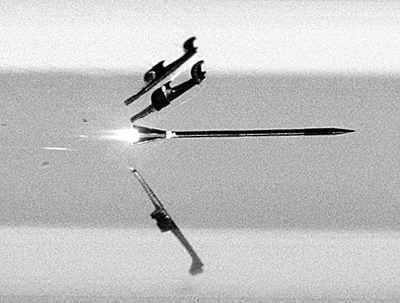One of the problems of small arms ammunition is that of swept volume. That is, the most ballistically efficient projectiles are the longest and thinnest ones, which cut through the air more easily than squatter, fatter projectiles. Yet, the best projectiles from a propulsion perspective are the widest ones, as they have the most area at their base for the expanding gases to push on, making them more efficient, especially from shorter barrels.
In a conventional gun, these two dimensions cause a compromise: A wider projectile increases the efficiency of the gun, reduces barrel heating and wear, and reduces velocity loss from shorter barrels, but it doesn’t fly as far as a thinner, sleeker projectile. But, there is a solution: Sabots. From the French word for “shoe”, a sabot – or more correctly a discarding sabot – is a piece of material that bridges the gap between the thin, sleek projectile, and the wide, efficient bore of the gun. Sabots guide the bullet down the barrel efficiently, but are discarded after the projectile exits the muzzle of the weapon, and do not carry on to the target.
Sabots come in several forms, which can be simplified into two dimensions:
- Pusher, or puller
and
- Cup-type, (for lack of a better term) splint-type, or disintegrating-type
The first point describes how the sabot engages with the projectile, whether it pushes from the back of the projectile, or pulls from the middle or front. The second describes how the sabot disengages from the projectile. Does it fall away from behind, fall off from the sides, or disintegrate entirely? In theory, a sabot could be made that embodied any one of the six combinations of the five types above, but generally only cup pusher, splint pullers, and disintegrating pullers are used.

An APFSDS tank round during sabot separation. The splint-puller type sabot falls off from the sides of the long, thin projectile, which carries on to the target.
Sabots are closely related to another topic we’ll be covering later, which is the drag-stabilized arrow-like flechette, but they have other applications, too. With conventional bullets, sabots allow for a smaller, longer projectile than could be otherwise practically rifling-stabilized, as the size of the rifling needed to spin such a projectile is larger and easier to make thanks to the wider bore. Also, a chambering could be made such that it was compatible with both saboted small-caliber bullets, and bore-riding large caliber subsonic projectiles, potentially giving future ammunition both the good trajectory of small-caliber high-velocity rounds like 5.56mm and the versatility of rounds like the .300 AAC Blackout. For high-velocity ammunition intended to be fired from very short barrels, sabots are potentially a huge boon, dramatically increasing the efficiency and therefore velocity of such ammunition. Finally, very high velocities at the limit of current propellants – those over 4,500 ft/s – are virtually only achievable with sabots.
However, this concept in the context of military small arms has been experimented with for well over the past 50 years, and hasn’t yet reached production status, which indicates that serious downsides exist. Typically, sabots significantly reduce the accuracy of the gun, as clean, repeatable separation of a small-caliber sabot from the projectile is very difficult to achieve. As a result, the dimensional tolerances of the sabot and projectile both need to be kept very small, which increases the cost of ammunition.
Even so, the sabot-driven long rod penetrator is the standard armor piercing ammunition of today’s armored fighting vehicles, and saboted projectiles have been successfully used with shotguns in hunting applications for years, so the concept is workable to some degree. Will it ever reach prime time for small arms?
 Your Privacy Choices
Your Privacy Choices
